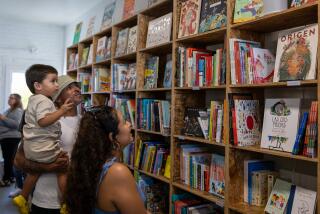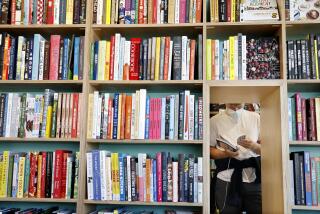Scholastic makes inroads into Arabic children’s book market
- Share via
Reporting from New York — — The publisher was on a rare and delicate mission to translate and mass-market books from America for a part of the world that often rails against American values.
Carol Sakoian, a vice president of Scholastic Inc., brought a small group of Arab officials into a conference room to screen a stack of stories. They read and read, about caterpillars, volcanoes, Amelia Earhart, and a big red dog named Clifford.
Who would imagine that Clifford could be considered inflammatory?
To observant Muslims he is, because dogs are considered ritually unclean. Scholastic wanted to be careful not to appear culturally imperialistic, so Clifford was put in the “no” pile.
The education ministers, who came from Bahrain, Lebanon and Jordan, drew up a list of 27 “no-nos,” according to Sakoian. “No dogs, no pigs, no boys and girls touching, no magic,” she said, naming a few.
They liked values and talk of honesty and cooperation among children. Anything that hinted at overly independent children or religion was eliminated. The colorful “I Spy” series was excluded after a tiny dreidel was spotted in a picture.
Scholastic, the world’s largest publisher and distributor of children’s books, first weeded its list of thousands of titles down to 200 and later 80. They were translated into Arabic, and over the last three years, almost 17 million copies have been shipped from a plant in Missouri to elementary schools across the Middle East and North Africa.
Initially these American imports were greeted with doubt in some quarters. A Jordanian father was so wary of reading materials coming from America that he read every Scholastic book in his son’s classroom. It took him a week to get through 40 titles, but eventually he gave his approval.
When similar books were offered in the Israeli-occupied West Bank, educators were also skeptical. After all, Israel’s friend, the U.S. government, was involved in underwriting the project. “Why would the United States make all these clearly expensive books available to us for free?” Tharat Zeid, a Palestinian Authority official, said local educators wondered.
After examining the books and learning that other Arab countries were using them, Zeid said the ministers decided, “Why not put politics and suspicions aside and benefit from them?” Two years later, with Scholastic’s “My Arabic Library” collections in 103 of 800 public schools, West Bank educators are clamoring for more and for training to show teachers how better to use them.
Chip Rossetti, an Arabic literature translator who writes about publishing in the Middle East, said a movement is growing to encourage a culture of reading for pleasure, which has mostly been a pastime of the elite. Beyond Cairo and Beirut — the publishing capitals — bookstores and well-stocked libraries are rarities in the Arab world, said Rossetti, noting that, though online sales are growing, books remain too pricey for most.
“I can’t point to an Arab Roald Dahl, Maurice Sendak or Beverly Cleary,” he said. “I know there are efforts to change that, but in these countries education tends to be more about rote learning, less about free reading.”
The U.S. and other Western governments have funded Arabic translations, particularly of textbooks. But Scholastic’s Arabic publishing effort is by far the largest, experts agree.
During an interview near the publisher’s global headquarters in Lower Manhattan, Sakoian said that she’d long ago set her sights on selling to the vast Arab market. She first approached a private foundation to underwrite translations but got nowhere. In post- 9/11 America, none was interested in supporting Arab culture, she said. The U.S. State Department eventually paid for translations through a democracy-building initiative and for printing about half the books.
But Scholastic had a long way to go before it started printing. First, it had editing to do even of classics. Because Islam does not acknowledge the celebration of birthdays, “Ladybug’s Birthday” was renamed “Ladybug’s Anniversary.” Ms. Frizzle’s students on “The Magic School Bus” were given Arabic-sounding names, skirts were lengthened, body parts were covered and the skin tone and hair of the Swiss orphan girl in “Heidi” was darkened for the Arabic edition. (A tiny church steeple on the cover picture of Heidi’s village escaped notice, however. “We just couldn’t catch everything,” Sakoian said.)
Scholastic scoured the books to eliminate anything that could be interpreted as American propaganda. In a book about shapes, a flag was removed from the Pentagon building in Washington, D.C. “This was a publishing project, not a diplomatic project,” Sakoian said.
Still, she often found herself in the role of diplomat as Scholastic attempted to develop translations that would be acceptable across the Arab world. Although modern Arabic remains the official, unifying language, most people use local dialects with vocabulary that may differ from country to country. Again, Sakoian convened an Arab panel to review every word and phrasing in every book. They pored over dictionaries and, when there were disputes, turned to the Koran as the arbiter of what is correct.
Scholastic had 80 manuscripts ready to go to the printer when it was pointed out there were no accent marks — and without them the books couldn’t be read. They were added, and by late 2007, Scholastic began printing in Arabic in its Jefferson City, Mo., plant and shipping to Bahrain, Jordan, Lebanon, Libya, Morocco and Iraq, where U.S. soldiers delivered books to battle zones. Scholastic has since sent collections along with teaching manuals to 23 Arab-speaking countries.
For the publisher, which ships 1 million books a day out of Jefferson City, the Arabic books represent only a small part of its $2-billion business. But Sakoian sees greater business and cultural opportunities ahead. “Parents in these countries are like parents everywhere,” she said. “They want their children educated, and this is basic stuff. Spiders, penguins and alligators do not belong to America.”
Shereen Kreidieh Hasbini, a children’s book publisher in Beirut, said Scholastic should have included books about Arabic culture. “A mixture of books that deal with issues that they face in their life with some translations would have made it a rich collection,” she wrote in an e-mail.
Already, this literary infusion has transformed some children in a poor, religious neighborhood on the West Bank into critical thinkers. After using Scholastic books, sixth-graders at Al Bireh Elementary School in Ramallah found they preferred nonfiction to fiction, a report about life in India to a tale of a 19th century “Heidi.” (Yara Firas, 11, didn’t like the classic about the orphan sent to live with a grumpy grandfather. “I do not like sad stories,” Yara said.)
Second-graders were mesmerized by a book about ethnicity, “We Are All Alike We Are All Different,” said their teacher Ahlam Said: “The students could not understand this book because we do not have different ethnic groups here as there may be in the West. I tried to explain ... some understood but others did not. It is OK because they were able to get an idea about different ethnic groups from around the world.”
Al Bireh’s principal, Abu Baker, noticed that a book about African Americans gave students insight not only into how others live but also into themselves. They realized “they are not the only ones suffering because of the political situation in Palestine and the occupation, but that there are other people in other parts of the world who are also suffering from maybe different reasons,” she said.
Maher Abukhater contributed reporting from the West Bank.
More to Read
Sign up for our Book Club newsletter
Get the latest news, events and more from the Los Angeles Times Book Club, and help us get L.A. reading and talking.
You may occasionally receive promotional content from the Los Angeles Times.







